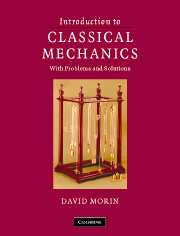Book contents
- Frontmatter
- Contents
- Preface
- 1 Strategies for solving problems
- 2 Statics
- 3 Using F = ma
- 4 Oscillations
- 5 Conservation of energy and momentum
- 6 The Lagrangian method
- 7 Central forces
- 8 Angular momentum, Part I (Constant L^)
- 9 Angular momentum, Part II (General L^)
- 10 Accelerating frames of reference
- 11 Relativity (Kinematics)
- 12 Relativity (Dynamics)
- 13 4-vectors
- 14 General Relativity
- Appendix A Useful formulas
- Appendix B Multivariable, vector calculus
- Appendix C F = ma vs. F = dp/dt
- Appendix D Existence of principal axes
- Appendix E Diagonalizing matrices
- Appendix F Qualitative relativity questions
- Appendix G Derivations of the Lv/c2 result
- Appendix H Resolutions to the twin paradox
- Appendix I Lorentz transformations
- Appendix J Physical constants and data
- References
- Index
Preface
- Frontmatter
- Contents
- Preface
- 1 Strategies for solving problems
- 2 Statics
- 3 Using F = ma
- 4 Oscillations
- 5 Conservation of energy and momentum
- 6 The Lagrangian method
- 7 Central forces
- 8 Angular momentum, Part I (Constant L^)
- 9 Angular momentum, Part II (General L^)
- 10 Accelerating frames of reference
- 11 Relativity (Kinematics)
- 12 Relativity (Dynamics)
- 13 4-vectors
- 14 General Relativity
- Appendix A Useful formulas
- Appendix B Multivariable, vector calculus
- Appendix C F = ma vs. F = dp/dt
- Appendix D Existence of principal axes
- Appendix E Diagonalizing matrices
- Appendix F Qualitative relativity questions
- Appendix G Derivations of the Lv/c2 result
- Appendix H Resolutions to the twin paradox
- Appendix I Lorentz transformations
- Appendix J Physical constants and data
- References
- Index
Summary
This book grew out of Harvard University's honors freshman mechanics course. It is essentially two books in one. Roughly half of each chapter follows the form of a normal textbook, consisting of text, along with exercises suitable for homework assignments. The other half takes the form of a “problem book,” with all sorts of problems (and solutions) of varying degrees of difficulty. I've always thought that doing problems is the best way to learn, so if you've been searching for a supply to puzzle over, I think this will keep you busy for a while.
This book is somewhat of a quirky one, so let me say right at the start how I imagine it being used:
As the primary text for honors freshman mechanics courses. My original motivation for writing it was the fact that there didn't exist a suitable book for Harvard's freshman course. So after nine years of using updated versions in the class, here is the finished product.
As a supplementary text for standard freshman courses for physics majors. Although this book starts at the beginning of mechanics and is self contained, it doesn't spend as much time on the introductory material as other freshman books do. I therefore don't recommend using this as the only text for a standard freshman mechanics course. However, it will make an extremely useful supplement, both as a problem book for all students, and as a more advanced textbook for students who want to dive further into certain topics.
[…]
- Type
- Chapter
- Information
- Introduction to Classical MechanicsWith Problems and Solutions, pp. xiii - xviiiPublisher: Cambridge University PressPrint publication year: 2008

